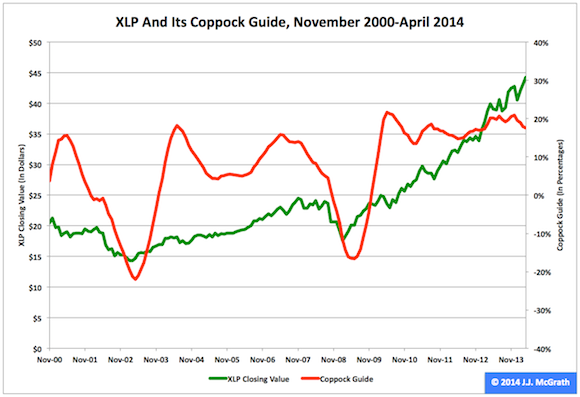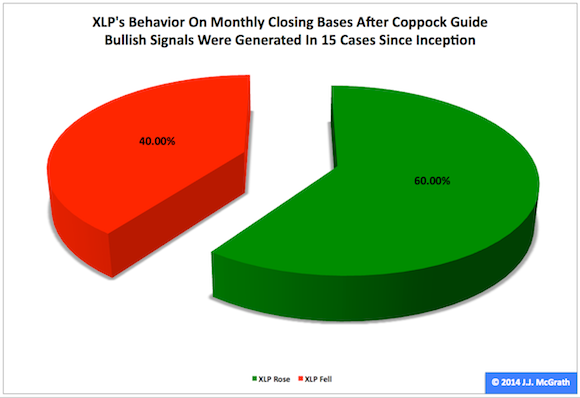Over this period, XLP’s return was less than one-quarter
that of the Utilities SPDR ETF (XLU)
and less than 1-1/2 times that of the SPDR S&P 500 ETF (SPY), as described in “XLU Coppock Guide: Bullish as of May Day 2014.”
(XLU returned 14.74 percent, and SPY returned 2.41 percent.)
XLP is the fifth of 13 ETFs to be featured in a J.J.’s Risky
Business blog series this month. Basically, I will be looking at each
ETF with both eyes fixed on its Coppock guide, as was the case in “SPY Coppock Guide: Away From Bullishness, Toward
Nonbullishness as of March 31, 2014.” The Coppock guide, aka either the
Coppock curve or the Coppock indicator, is a long-term indicator of price
movements in major stock-market indexes calculated on the basis of monthly
data.
Figure 1: XLP And Its
Coppock Guide, The Complete History
Note: The XLP
closing-value scale is on the left, and the Coppock guide scale is on the
right.
Source: This J.J.’s
Risky Business chart is based on
proprietary analyses of Yahoo Finance adjusted monthly share-price data and those data themselves.
Edwin S. Coppock developed his long-term guide not to flash both
bullish and bearish signals but to generate only bullish signals. However, I
employ it to produce either bullish or nonbullish signals. It is extremely
important to keep in mind that a nonbullish signal is not equivalent to a bearish signal in the context of the
guide.
I anticipate XLP may rise after a bullish signal and expect
it might do anything following a nonbullish signal (i.e., trade higher, lower
or sideways).
Figure 2: XLP’s
Behavior Subsequent To Initial Bullish Signals
Source: This J.J.’s
Risky Business chart is based on
proprietary analyses of Yahoo Finance adjusted monthly share-price data.
The epitome of mediocrity, the XLP Coppock guide’s initial
bullish signals collectively may have done better than coin flips would have
done in forecasting the future upward movements of the ETF on monthly closing
bases since inception. However, they may have done so not by a lot but by a
little. In 15 cases since November 2000, these signals have been correct on nine
occasions, or 60.00 percent of the time, and incorrect on six occasions, or 40.00
percent of the time.
To put this aberrant behavior in its proper perspective, I
note the Coppock guide’s initial bullish signals for each of the four ETFs
already covered in my “Coppock Guide: The Blog Series” compiled better
success-failure rates than did XLP. They ranged from the best, those for the
Utilities Select Sector SPDR (XLU),
with 100.00 percent right and 0.00 percent wrong, to the worst, those for the
Health Care Select Sector SPDR (XLV),
with 83.33 percent right and 16.67 percent wrong.
Figure 3: XLP’s
Behavior Subsequent To Initial Nonbullish Signals
Source: This J.J.’s
Risky Business chart is based on
proprietary analyses of Yahoo Finance adjusted monthly share-price data.
XLP’s performance after the Coppock guide’s initial nonbullish
signals has been similar to the ETF’s performance following the Coppock guide’s
initial bullish signals. However, the former’s track record is at least
comprehensible because a nonbullish signal is not equivalent to a bearish signal in the context of the Coppock
guide.
In the wake of the 14 XLP Coppock guide’s initial nonbullish
signals since November 2000, the ETF’s adjusted share price on a monthly
closing basis has fallen on six occasions, or 42.86 percent of the time, and
risen on eight occasions, or 57.14 percent of the time.
The latest XLP Coppock guide’s initial nonbullish signal
flashed in December, when the ETF’s closing share price was $42.76. The
comparable figure was $44.24 in April.
I believe the Coppock guide’s signals in general are helpful
long-term indicators of price movements in major market indexes, but I think
the XLP Coppock guide’s signals in particular are about as useful as the New
York-to-California flight plan filed by Douglas “Wrong Way” Corrigan in July
1938: The aviator’s Curtiss Robin Sunshine
rose in New York on July 17, all right, but it set down in Ireland on July 18.
Longtime observers of the XLP Coppock guide know the feeling.
Coppock Guide: The
Blog Series
Related Reading
Author’s Note: This is
the fifth blog post in a May series centered on the Coppock guides of 13
important ETFs, among them all nine Select Sector SPDRs. The first was
cross-posted at both J.J.’s Risky Business and
J.J. McGrath’s Instablog on Seeking Alpha, but the rest of the series will be posted here. You can follow me
(and the series) @JJMcGrath3000 on Twitter, at JJMcGrath on StockTwits and via myself on Google+.
Disclaimer: The opinions
expressed herein by the author do not constitute an investment recommendation,
and they are unsuitable for employment in the making of investment decisions.
The opinions expressed herein address only certain aspects of potential
investment in any securities and cannot substitute for comprehensive investment
analysis. The opinions expressed herein are based on an incomplete set of
information, illustrative in nature, and limited in scope. In addition, the
opinions expressed herein reflect the author’s best judgment as of the date of
publication, and they are subject to change without notice.



No comments:
Post a Comment